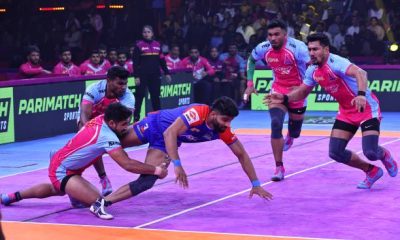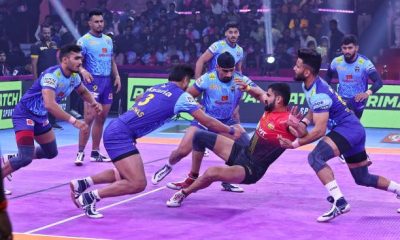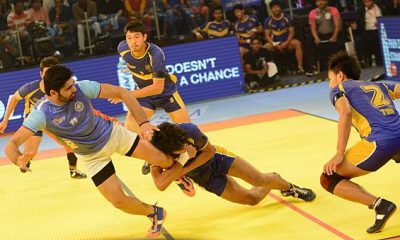
Introduction: The Origins of Kabaddi
Kabaddi, one of India’s oldest and most celebrated sports, has transitioned from a rural pastime to an international competitive sport. Originating over 4,000 years ago, it was traditionally played in Indian villages as a test of strength, agility, and strategy.
Over the past few decades, Kabaddi has gained global recognition, thanks to leagues like the Pro Kabaddi League (PKL) and international tournaments such as the Kabaddi World Cup.
In this article, we’ll explore:
✅ The history and origins of Kabaddi
✅ How the game is played
✅ The global expansion of Kabaddi
✅ The impact of Pro Kabaddi League (PKL)
✅ Kabaddi’s future in global sports

The Ancient Roots of Kabaddi
Where Did Kabaddi Originate?
Kabaddi traces its roots back to ancient India, with historical records indicating that it was played as a combat training exercise for warriors.
✔ Some believe that Kabaddi was played during the time of the Mahabharata, where warriors showcased their ability to infiltrate enemy lines and return safely.
✔ Traditionally played in mud courts, Kabaddi became a popular sport in rural India, especially in Punjab, Tamil Nadu, Maharashtra, and Haryana.
💡 Fact: The word “Kabaddi” is derived from the Tamil word “Kai-pidi”, meaning “holding hands.”
How Kabaddi is Played: Rules & Gameplay
Kabaddi is a contact sport played between two teams of seven players on a rectangular court. The objective is simple:
1️⃣ A “raider” enters the opponent’s half to tag defenders and return to their side without being tackled.
2️⃣ The raider must continuously chant “Kabaddi, Kabaddi” while inside the opponent’s half.
3️⃣ Defenders must work together to tackle and stop the raider from escaping.
4️⃣ Teams score points by tagging opponents and tackling raiders.
✔ The game requires strength, agility, and strategic teamwork.
✔ There are two main formats: Circle Kabaddi (played in rural areas) and Standard Kabaddi (played internationally).

Kabaddi’s Global Expansion
How Did Kabaddi Become an International Sport?
Though deeply rooted in India, Kabaddi has expanded beyond South Asia, with international federations organizing global tournaments.
✔ The first Kabaddi World Cup was held in 2004, followed by editions in 2007, 2010, 2016, and beyond.
✔ Today, more than 30 countries actively play Kabaddi, including Iran, South Korea, Kenya, and Canada.
💡 Fact: Iran is one of the strongest non-Indian teams, winning the 2018 Asian Games Kabaddi gold medal.
The Pro Kabaddi League (PKL) & Its Impact
What is the Pro Kabaddi League (PKL)?
Launched in 2014, the Pro Kabaddi League (PKL) revolutionized Kabaddi by introducing a franchise-based league format, similar to the Indian Premier League (IPL).
✔ PKL attracted millions of viewers, making Kabaddi a mainstream sport in India.
✔ The league features star players, including Pardeep Narwal, Ajay Thakur, and Fazel Atrachali.
✔ The 2019 PKL season saw a record-breaking 1.2 billion TV viewers, making it India’s second-most-watched league after the IPL.
💡 Impact of PKL:
- Increased professionalism & player salaries
- Massive TV & digital viewership
- Foreign player participation (Iran, South Korea, Kenya, etc.)
- Rise in sponsorship & brand deals
🚀 PKL transformed Kabaddi into a commercially successful global sport!
SUGGESTED FOR YOU

International Growth of Kabaddi
While India remains the powerhouse of Kabaddi, other nations are catching up.
Countries Where Kabaddi is Growing:
🌏 Iran – The strongest non-Indian team, winning the 2018 Asian Games.
🌏 South Korea – Shocked India in the 2016 Kabaddi World Cup.
🌏 Kenya – Emerging as Africa’s Kabaddi force.
🌏 Canada & USA – Indian diaspora fueling the sport’s rise.
🌏 Bangladesh, Nepal, Sri Lanka – Strong traditional Kabaddi cultures.
💡 Future of Kabaddi: Efforts are underway to include Kabaddi in the Olympics by 2032!
Why Kabaddi is Gaining Global Popularity
✔ Fast-paced & thrilling action – Short matches keep fans engaged.
✔ Simple rules & low-cost infrastructure – No expensive equipment needed.
✔ Expanding international leagues – More countries are adopting the sport.
✔ Digital & TV coverage – PKL and global tournaments are easily accessible online.
💡 Kabaddi’s growth mirrors that of MMA and esports—fast, exciting, and engaging for younger audiences!

CHECK OUT TOP 3 FREE BETTING PREDICTION SITES
Accuratepredict.com Soccerpredictions.net Betloy.com
The Future of Kabaddi: What’s Next?
As Kabaddi continues to grow globally, the sport’s future looks brighter than ever. Here’s what to expect:
🚀 More International Leagues – New Kabaddi leagues emerging in Iran, South Korea, and Kenya.
🚀 Increased Olympic Push – Kabaddi could be an official Olympic sport by 2032.
🚀 Higher Player Salaries – PKL is creating Kabaddi superstars with record contracts.
🚀 Expanded Digital Viewership – More streaming options for global Kabaddi fans.
🎯 Prediction: By 2030, Kabaddi will be one of the world’s fastest-growing sports with major leagues outside India.
Final Verdict: Why You Should Follow Kabaddi
🎯 Kabaddi is no longer just an Indian village game—it’s a fast-growing global sport!
🎯 With PKL, international tournaments, and Olympic ambitions, Kabaddi is reaching new heights.
🎯 If you love action-packed sports with strategy, skill, and teamwork, Kabaddi is a must-watch!
💡 Want to start following Kabaddi? Watch the Pro Kabaddi League and global tournaments to see this incredible sport in action! 🚀🔥
🔥 Are you ready to explore the world of Kabaddi? Follow the latest tournaments and experience the excitement of this fast-growing global sport! 🎯💪









